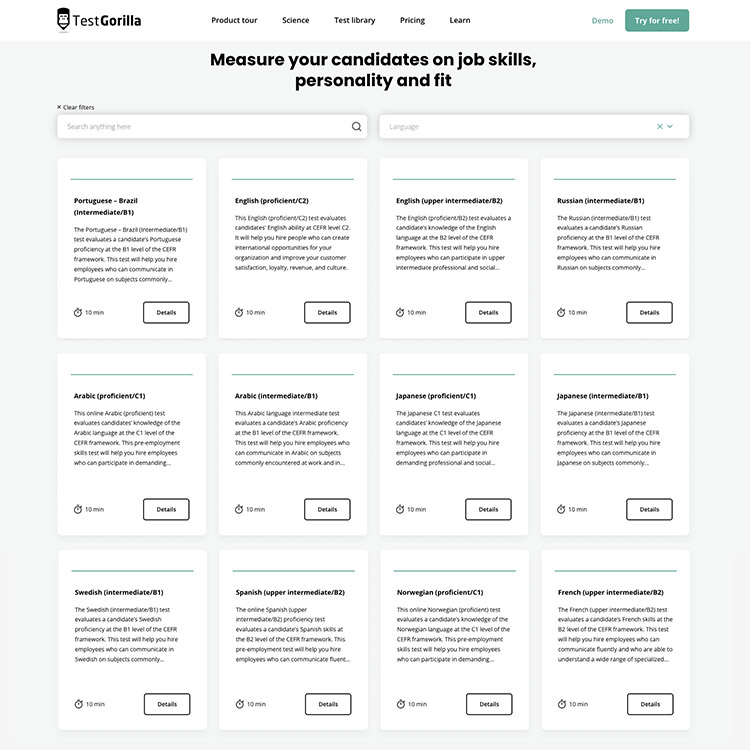Hiring an independent contractor: How talent assessments help employers evaluate freelancer skill
Employers are facing a serious talent shortage. Between 2010 and 2020, the traditional pool of entry-level workers aged 16-24 shrank in size, leaving businesses struggling to find the talent they need.[1]
And as existing workers make career moves and life changes, it’s hard for employers to retain top talent, too.
Hiring a contractor is a quick and effective solution to a talent shortage in your workplace.
But how can you verify independent contractors’ skills and capabilities to ensure you’re working with the best?
It’s simple: Use skills-based hiring techniques to screen for vital skills before you commit to hiring an independent contractor.
In this guide, we explore what independent contractors are, why they can be a challenge to hire, and our top tips for using talent assessments to streamline your process for hiring an independent contractor.
Table of contents
- What are independent contractors?
- The difficulties with hiring a contractor
- How talent assessments help with hiring a contractor for your business
- 7 ways to use talent assessments to optimize hiring an independent contractor
- Beyond talent assessments: 5 best practices to remember for hiring a contractor
- Make hiring a contractor stress-free with skills-based hiring
What are independent contractors?
Independent contractors are workers who perform services for other individuals or businesses. But they aren’t directly employed by those entities; they’re self-employed instead.
That makes independent contractors different from regular employees in several important ways:
They aren’t eligible for employment benefits
Their taxes aren’t withheld from their paychecks, so they pay taxes on their own behalf
They arrange their own insurance and retirement accounts
If you hire an independent contractor, you’re considered to be their client, not their employer. But you are still responsible for knowing the difference between contractors and employers – and to classify all your workers correctly.
Your legal obligations vary depending on whether you treat a worker as an employee or a contractor. If you’re a US-based business, you have a legal responsibility to issue Form 1099-MISC to any contractor you pay more than $600 in a year.
Depending on your state, you may also have a legal obligation to pay invoices sent by your contractors within a certain time frame.
For example, New York State’s Freelance Isn’t Free Act requires clients to pay independent contractors for their work within 30 days of the work being completed.
The difficulties with hiring a contractor
Hiring contractors is a great way for businesses to address skills shortages. But searching for the right contractor for the job isn’t always straightforward.
In fact, businesses seeking reputable contractors face many of the same challenges as those searching for new employees. As workers prioritize their own needs in the Great Reshuffle, employers need to offer a better deal to attract top talent.
Even though contractors don’t receive traditional employment benefits, they might expect other perks, such as higher pay or greater flexibility when setting deadlines.
But the difficulties of hiring a contractor don’t end with attracting potential workers. When trying to choose the right worker for the job, you need to tackle all of the following challenges, too.
Confirming a contractor’s abilities
In the 2020s, hiring from resumes is fraught with problems:
Applicants can’t fit all relevant information about their skills in a resume
Candidates may lie or misrepresent themselves on their resumes
Resumes are hard for time-pushed recruiters to parse quickly, slowing the hiring process
All of these factors make it hard to confirm exactly what an independent contractor can do through resume-based hiring. And with mis-hires costing the US economy more than $1tn each year, you risk making expensive mistakes when you hire based on resumes alone.
Hiring an independent contractor remotely
Many independent contractors prefer to work remotely. Some even live as digital nomads, working from anywhere while traveling around the world.
But HR professionals who use traditional hiring methods are often blindsided when they can’t interview candidates in person. When hiring remote employees, they find it hard to gauge their abilities – or even just their tone during a remote interview.
If your hiring managers aren’t able to assess candidates remotely, they risk missing out on a global pool of talent.
Gauging a contractor’s language proficiency
As remote and distributed work gets easier, businesses all around the world have an unprecedented opportunity to broaden their access to talent through remote or hybrid hiring.
But when hiring contractors globally, you need to know how well candidates can speak the language you work in. And unless you have a reliable means of testing their linguistic ability, that can be tough.
Of course, you can specify that you want to recruit native speakers only, but you might be violating employment discrimination laws depending on where you work. You also risk losing access to talented contractors who have learned your working language successfully.
The best insights on HR and recruitment, delivered to your inbox.
Biweekly updates. No spam. Unsubscribe any time.
How talent assessments help with hiring a contractor for your business
These challenges shouldn’t deter you from working with contractors. Data shows that 71% of hiring managers plan to maintain or increase their use of independent contractors in the coming months – and you could be one of them.
With skills-based hiring methods, the process of hiring an independent contractor becomes much less complicated.
In TestGorilla’s State of Skills-Based Hiring report, we found that:
92% of companies using skills-based hiring saw a reduction in mis-hires
91.4% saw a reduction in total time-to-hire
89.8% saw a reduction in total cost-to-hire
Skills-based hiring streamlines the hiring process, improving efficiency and reducing the number of errors in the process.
It also empowers businesses to build a more diverse workforce, with 91% of surveyed companies seeing improvements in diversity thanks to skills-based hiring.
That’s because skills-based hiring levels the playing field for nontraditional candidates. It opens up new opportunities to people without specific qualifications or backgrounds, enabling a broader range of workers to achieve success in their fields.[2]
This is particularly important when hiring contractors, who often stand outside the traditional workforce. Different types of contractors obtain work based on skills and abilities – such as writing, coding, or graphic design – that may not stem from formal qualifications or work experience.
Their skills are what matters, so as a hiring manager, it’s important to focus on identifying and gauging those skills when hiring an external contractor.
As the way we organize work changes, the approaches that work best for hiring contractors will become more broadly applicable. Research from Deloitte indicates a move toward either broadened work or fractionalized work – both approaches rely on skills and abilities to assign work to workers.
In a way, contractors are already fractionalized workers. They flow toward the assignments and tasks that suit their skills and abilities best. As an HR professional, you can secure the services of the best contractors by testing their skills during the hiring process.
7 ways to use talent assessments to optimize hiring an independent contractor
Talent assessments come with major advantages for hiring managers. They’re more objective, more reliable, and more likely to yield results than traditional, non-skills-based hiring methods.
And crucially, they work for both direct recruitment and the process of hiring an independent contractor.
Use these top tips to get the most out of talent assessments and unlock the full benefits of hiring an independent contractor.
Hiring contractors with talent assessments at a glance
How to use talent assessments | How it helps |
Verify a contractor’s real abilities without relying on resumes | Avoids the risk of mis-hires by making it harder for candidates to misrepresent their abilities |
Hire contractors with nontraditional backgrounds | Encourages diversity and innovation within your workforce |
Ensure contractors add to your culture | Contributes to your positive company culture without the risk of implicit bias in hiring |
Match contractors’ skills to your needs | Creates a more efficient hiring process by enabling you to see where contractors can be put to best use |
Enjoy a faster time-to-hire | Improves hiring efficiency and increases company productivity |
Assess contractors’ language proficiency | Broadens your business’s access to global talent |
Upskill contractors into full-time employees | Empowers you to make the most of the talent already available to you while encouraging employee development |
1. Verify a contractor’s real abilities without relying on resumes
It’s easy to lie on a resume. When a company doesn’t take steps to assess candidates’ skills before committing to a hire, candidates have an easy time claiming to have skills and abilities they don’t actually have.
This misrepresentation leads to mis-hires, which are expensive and often difficult for businesses to resolve.
Skills-based hiring can help. Study abroad consultancy company IDP Education turned to skills-based hiring methods after mis-hiring two employees for the same position.
The business wanted to find the perfect candidate and improve the hiring process for the future. Since adopting pre-employment skills testing, the company has found it easier and more efficient to screen out unqualified candidates and hire the best.
If you know the skills a contractor will need to deliver great results for your business, don’t look for them on their resume. Instead, set up pre-employment assessments of those skills for the contractor to prove their abilities.
2. Hire contractors with nontraditional backgrounds
As we’ve seen, contingent workers like contractors may not have extensive work history or education in their field of work. They might have studied a foreign language in school, only to take up freelance graphic design later in life.
Newer contractors may not have much evidence of previous successful work either. Although reading testimonials from their previous clients is helpful, relying on that approach risks excluding potential HiPos from your hiring strategy.
Skills testing takes the burden of proof off a contractor’s work history and background. Instead, it gives them the option to prove themself by demonstrating their skills and abilities to you. You get to see exactly what they can do for you.
Here’s how to use TestGorilla’s wide range of skill tests to hire the best contractor for the job:
Name the role you’re hiring for (for example, “Graphic Designer”)
Choose whether to use our pre-made assessment template for that role or build your own custom assessment
If building your own assessment, choose the tests you want candidates to take, such as Adobe InDesign or Attention to Detail (Visual)
Add any custom questions you want candidates to answer
Adjust any other relevant settings, such as anti-cheating features or special accommodations
3. Ensure contractors add to your culture
Culture add – the values and behaviors that workers contribute to your company culture – is more important than most HR professionals realize. It’s a way to ensure your culture keeps evolving for the better.
And because hiring for culture add limits the biases that otherwise come into play, it’s also ideal for diversity hiring.
But direct employees aren’t the only people who influence your workplace culture. Your contractors play a part, too.
Use TestGorilla’s Culture Add test to gauge culture add at the point of hiring. Here’s how to do it:
Set up an assessment for the role you need to fill, following the steps above
When choosing tests for your assessment, select the Culture Add test
Add any custom questions and adjust any other settings
4. Match contractors’ skills to your needs
Sometimes, contractors offer real cultural add and amazing skills, but they aren’t the skills you need for the type of project you have in mind.
Rejecting contractors in these situations feels wasteful. It’s a waste of time and resources for both parties, and a waste of money for your company.
You may be able to avoid that waste if you perform regular skills gap analyses within your company. Testing your existing workforce and identifying skills gaps is an easy way of understanding hiring needs for your business.
Then when recruiting contractors, test their skills as broadly and thoroughly as you can during the hiring process. If they aren’t the right fit for the project you’re hiring for, compare their test results to your skills gap analysis to understand where else they could fit.
For example, imagine a company recruiting for a contractor with copywriting experience. The company also needs a Google Ads specialist and asks candidates for the copywriting job to take the Google Ads test, too.
The company recruits the top candidate for the copywriting job but identifies another candidate who understands Google Ads inside out. It offers that candidate work in developing its Google Ads marketing strategy without needing to recruit again for that work.
This keeps the recruitment process as efficient as possible, lowering hiring costs and saving time for everyone involved.
5. Enjoy a faster time-to-hire
Traditional hiring methods can hurt your company’s hiring efficiency. Software development firm SiddhiSai learned this the hard way. The company needed to speed up its hiring process and couldn’t make its manual tests both efficient and reliable.
As a result, not only was its hiring process long and frustrating for everyone involved, but it often resulted in bad hires.
But using TestGorilla, the firm was able to build custom skills tests tailored to its business needs. The new tests were more accurate, more efficient, and more helpful in avoiding costly mis-hires.
Most importantly, they led to a faster time-to-hire without compromising the integrity of the hiring process.
Use our wide range of pre-made skills tests for maximum efficiency, or construct your own if you’re hiring for roles with specific requirements. Either way, our tests will cut your time to hire and save you valuable time.
6. Assess contractors’ language proficiency
There are plenty of great reasons to build a global workforce:
Diverse perspectives
Improved creativity
A broader customer base
Increased organizational agility and resilience
But there’s one major logistical challenge when hiring remote employees from around the world. You need to make sure they have the required level of proficiency in your working language.
Language testing is also useful when hiring international customer support staff. When you’re running a global company, you need to deliver global customer support – which means hiring workers who can deal with clients in their language.
TestGorilla makes it simple to assess a contractor’s language ability. Just select the language and skill level you need from our wide range of language tests. They’re based on the CEFR framework, so you can trust that they’ll hold candidates to a recognized standard.
Then use the results to select the independent contractors with the language ability your company needs.
7. Upskill contractors into full-time employees
Internal recruitment is a great way to make use of the talent you already have. It limits the costs of hiring externally and promotes internal mobility within your organization.
But if you focus solely on internally recruiting your direct employees, you risk missing out on another untapped source of potential: your independent contractors.
If your contractors are doing great work for you and you think they have the potential to succeed as full-time employees, it’s time to consider upskilling and recruiting them.
When you have a role in mind for a contractor, your first step should be using skills tests to assess their current level of ability. Identify the skills they’ll need to thrive in the role, and invite them to take the relevant TestGorilla tests.
From there, you can use your existing employee training and development methods to upskill them where necessary, in preparation for a direct role within your business.
Beyond talent assessments: 5 best practices to remember for hiring a contractor
Assessing potential contractors is only the beginning. When you work with independent contractors, you need to make sure that you meet all your legal obligations – both to the contractors themselves and to the government.
Here are the five most important steps you can take to ensure you hire your contractors legally and ethically.
1. Know the difference between independent contractors and employees
As an HR professional, it’s crucial that you understand how an independent contractor is different from an employee. You need to know this to avoid problems ranging from staff confusion to serious legal trouble.
To understand the key differences, use this simple table to compare the two:
Independent contractors | Employees |
Self-employed | Employed directly by your business |
Paid via invoice | Paid via your company’s payroll |
Pays their own taxes | Relevant taxes are withheld from their paycheck by your business |
Not eligible for employment benefits | Eligible for employment benefits |
Sets their own hours and defines their own place of work | Usually works arranged hours in a location agreed with your company |
Usually works on projects with clear, specific endpoints | Usually performs ongoing and continual work |
If you misclassify an employee, you should expect to pay their back wages. You may also have to pay a penalty of up to $1,000 per misclassified employee or face up to a year of jail time.
If you’re hiring contractors in California, you should be aware of Assembly Bill 5. This law means certain independent contractors are legally classified as employees.
2. Treat your contractors as fairly as you treat your employees
There are excellent reasons to think of contractors and employees as different types of workers. But none of that means you should treat your contractors as lesser than your direct employees.
They’re still people working on your behalf, and it’s worth your time to ensure they feel happy, comfortable, and well supported while they’re aligned with your company.
The employee life cycle model is a roadmap for an employee’s experience of your company. That model doesn’t always apply to contractors because the goal of the employee life cycle approach is to build a long-term relationship between employer and worker.
But it’s important to think about the ways it does apply. Processes like onboarding, for example, give contractors a clear sense of where they fit into the bigger picture, while providing them with valuable early support as they start work.
When you plan to hire independent contractors, make sure you plan to make them welcome, too. Referrals from happy contractors are a valuable way to find talent, too.
3. Write up detailed contracts for your contractors
When a business hires a contractor, it’s useful for both parties to have a clear picture of their obligations to each other.
That’s where written contracts come in. They aren’t always legally necessary, but they’re a great way for businesses to show upfront that they take the process of hiring an independent contractor seriously.
And in case things do go wrong between the two parties, a contract helps to clarify what happens next – whether or not the contractor and the company part ways and issue the final payment.
A good contract should include the following elements:
A list of the services the contractor will provide
The expected duration of the work or set completion date
The rate of pay, terms of payment, and payment schedule
Any confidentiality or non-compete agreements
A notice period for the termination of the work agreement
Even if your company hires the same contractor for multiple projects, each project should come with its own contract. This keeps everyone’s obligations and responsibilities clear.
4. Request W-9s and keep them on file
Form W-9 is an IRS tax form used to confirm an independent contractor’s name, address, and taxpayer identification number (TIN). It’s typically requested by businesses as part of the new hire paperwork processes.
Unlike the W-4 form, which is generally issued to direct employees, the W-9 doesn’t arrange for any taxes to be withheld from a contractor’s pay.
Instead, companies use the W-9 to gather the information they need to generate Form 1099. Businesses need to issue Form 1099 to independent contractors and the IRS to declare the amount they have paid to the contractor over a tax year.
Contractors are then responsible for paying taxes on that income.
To meet your legal obligations to the IRS, you need to request a completed W-9 form from every independent contractor you work with, even if they aren’t based in the US. You then need to keep those forms on file in case of a tax audit.
5. Keep a clear record of invoices
As we’ve mentioned, contractors usually request payment in the form of an invoice. This makes them different from direct employees, who are paid via payroll.
When you hire a contractor, it’s your responsibility to ensure you pay them promptly and in full on receipt of an invoice. Remember, some US states have laws setting out how quickly you need to pay independent contractors when they invoice you.
Your responsibilities don’t end when you pay an invoice. You need to keep clear records about payments you have issued to contractors to keep track of your company’s money and where it’s going – and what project costs you’ve paid and what you haven’t.
Plus, if you are ever audited by the IRS, your company will benefit from good record-keeping. Well-organized past invoices allow auditors to see how money moves through your company.
Make hiring a contractor stress-free with skills-based hiring
Hiring an independent contractor might seem like a challenge. But with skills-based hiring methods, the process doesn’t have to be a source of anxiety for your hiring team.
By using skills tests to gauge your contractors’ skills and abilities accurately and efficiently, you can hire independent contractors with confidence. That’s true wherever your candidates are in the world and whatever languages they speak.
So whether you’re looking for a technical SEO specialist or an email marketer, trust TestGorilla’s proven skills-based methods to help you find the best contractors for the job.
Need an expert to guide your company through a specific project? Learn about hiring for niche skills, and see how skills-based methods help businesses find the expertise they need.
Sources
Bremen, John M. (January 30, 2023). “Why Talent Shortages Persist: Moving Beyond The Great Resignation And Quiet Quitting”. Forbes. Retrieved July 17, 2023. https://www.forbes.com/sites/johnbremen/2023/01/30/why-talent-shortages-persist-moving-beyond-the-great-resignation-and-quiet-quitting/
“Taking a skills-based approach to building the future workforce”. (November 15, 2022). McKinsey. Retrieved July 17, 2023. https://www.mckinsey.com/capabilities/people-and-organizational-performance/our-insights/taking-a-skills-based-approach-to-building-the-future-workforce
You've scrolled this far
Why not try TestGorilla for free, and see what happens when you put skills first.




















